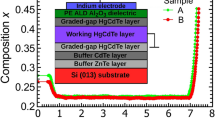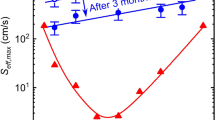Abstract
The possibility of forming a potential profile in a semiconductor by forming a metal film on its surface via selective removal of oxygen atoms from a deposited metal oxide layer was studied. Selective removal of atoms (SRA) was performed using a beam of accelerated protons with an energy of about 1 keV. Epitaxially grown GaAs films with a thickness of ∼100 nm and an electron concentration of 2×1017 cm−3 were chosen as the semiconductor material, and W obtained from WO3 was used as the metal. The potential profile appeared due to the formation of a Schottky barrier at the metal-semiconductor interface. It was found that the Schottky barrier formed at W/GaAs contacts made by the SRA method is noticeably higher (∼1 eV) than the barrier formed at the contacts made by conventional metal deposition (0.8 eV for W/GaAs). The data presented indicate that there is no damaged layer in the gate region of the structures, which is most strongly affected by the proton irradiation. Specifically, it was shown that the electron mobility in this region equals the mobility in bulk GaAs with the same doping level.
Similar content being viewed by others
References
C. Wyon, Nucl. Instrum. Methods Phys. Res. B 186, 380 (2002).
B. A. Gurovich, D. I. Dolgii, E. A. Kuleshova, et al., Usp. Fiz. Nauk 171, 105 (2001) [Phys. Usp. 44, 95 (2001)].
B. A. Gurovich, D. I. Dolgy, E. A. Kuleshova, et al., Microelectron. Eng. 69, 358 (2003).
S. Sze, Physics of Semiconductor Devices, 2nd ed. (Wiley, New York, 1981; Mir, Moscow, 1984), Vol. 1.
K. Seeger, Semiconductor Physics (Springer, Berlin, 1974; Mir, Moscow, 1977).
O. A. Golikova, Fiz. Tekh. Poluprovodn. (St. Petersburg) 31, 281 (1997) [Semiconductors 31, 228 (1997)].
I. V. Antonova, I. Stano, D. V. Nikolaev, et al., Fiz. Tekh. Poluprovodn. (St. Petersburg) 36, 65 (2002) [Semiconductors 36, 60 (2002)].
Author information
Authors and Affiliations
Additional information
__________
Translated from Fizika i Tekhnika Poluprovodnikov, Vol. 38, No. 9, 2004, pp. 1074–1078.
Original Russian Text Copyright © 2004 by Gurovich, Aronzon, Ryl’kov, Ol’shanski\(\overset{\lower0.5em\hbox{$\smash{\scriptscriptstyle\smile}$}}{l} \), Kuleshova, Dolgi\(\overset{\lower0.5em\hbox{$\smash{\scriptscriptstyle\smile}$}}{l} \), Kovalev, Filippov.
Rights and permissions
About this article
Cite this article
Gurovich, B.A., Aronzon, B.A., Ryl’kov, V.V. et al. Potential barrier formation at a metal-semiconductor contact using selective removal of atoms. Semiconductors 38, 1036–1040 (2004). https://doi.org/10.1134/1.1797481
Received:
Accepted:
Issue Date:
DOI: https://doi.org/10.1134/1.1797481




